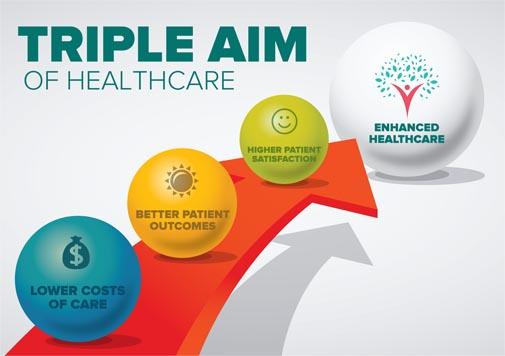Jun 22
2023
The Triple Aim In Healthcare: Advancing Quality, Reducing Costs, and Improving Patient Experience
 The Triple Aim framework has emerged as a guiding principle for healthcare organizations seeking to optimize patient care outcomes while simultaneously containing costs.
The Triple Aim framework has emerged as a guiding principle for healthcare organizations seeking to optimize patient care outcomes while simultaneously containing costs.
Developed by the Institute for Healthcare Improvement (IHI), the Triple Aim provides a holistic approach to healthcare delivery by focusing on three interrelated goals: improving population health, enhancing patient experience, and reducing healthcare costs.
This article aims to delve into the rationale behind the Triple Aim, its intended objectives, and its profound impact on health systems and medical providers.
The Need for a Transformation
The United States, like many other nations, faces several healthcare challenges, including escalating costs, inconsistent quality of care, and fragmented systems. The existing fee-for-service model has contributed to excessive healthcare spending without necessarily translating into improved patient outcomes. Consequently, the need for a fundamental transformation in healthcare delivery arose, giving rise to the Triple Aim.
The Triple Aim Explained: Improve Population Health
The first aim of the Triple Aim is to improve the overall health of populations. This involves addressing the determinants of health, promoting preventive care, and implementing evidence-based interventions to manage chronic diseases effectively. By focusing on population health, healthcare providers aim to reduce the incidence of preventable diseases and enhance the overall well-being of communities.
Enhance Patient Experience
The second aim of the Triple Aim is to enhance the patient experience of care. This encompasses various aspects, including improving access to care, fostering effective communication between patients and providers, ensuring care coordination, and respecting patients’ preferences and values. Patient-centered care lies at the heart of this aim, striving to create a healthcare system that meets the unique needs and expectations of each individual.
Reduce Healthcare Costs
The third aim of the Triple Aim seeks to reduce healthcare costs without compromising the quality of care. Healthcare systems are encouraged to adopt innovative approaches to resource management, eliminate waste, and streamline processes to achieve financial sustainability. By addressing inefficiencies and focusing on cost-effective care, the Triple Aim aims to make healthcare more affordable and accessible for all.
Impact on Health Systems
The Triple Aim framework has brought about significant transformations in health systems, driving organizational change and improving care delivery on multiple fronts. To achieve the Triple Aim, health systems have embraced care integration and coordination.
Siloed approaches are giving way to collaborative care models, where multidisciplinary teams work together to provide comprehensive and coordinated care across different healthcare settings. This shift fosters seamless transitions, reduces duplication of services, and ensures a more holistic approach to patient care.
Embracing Technology and Data Analytics
Healthcare organizations are increasingly leveraging technology and data analytics to achieve the Triple Aim objectives. Electronic health records (EHRs), telehealth, and remote patient monitoring enable more efficient care delivery, improve communication between providers and patients, and facilitate evidence-based decision-making. Harnessing the power of data enables health systems to identify trends, identify gaps in care, and tailor interventions to improve outcomes.
Impact on Medical Providers
The Triple Aim also has a profound impact on medical providers, necessitating a shift in their roles and responsibilities. The Triple Aim emphasizes interprofessional collaboration, requiring healthcare providers to work as cohesive teams. Physicians, nurses, pharmacists, social workers, and other healthcare professionals collaborate closely to deliver patient-centered care, leveraging their respective expertise to address the multiple dimensions of health.
Focus on Prevention and Population Health Management
The Triple Aim encourages medical providers to adopt a proactive approach to healthcare. Rather than solely addressing acute illnesses, providers are increasingly involved in preventive measures and population health management. This involves promoting healthy behaviors, conducting screenings, and managing chronic conditions through regular monitoring and education.
Conclusion
The Triple Aim framework has revolutionized healthcare delivery, providing a roadmap for health systems and medical providers to achieve improved patient outcomes, enhanced patient experience, and reduced costs. By integrating population health, patient-centered care, and cost containment, the Triple Aim aims to create a sustainable and effective healthcare system that meets the needs of individuals and communities.
As healthcare continues to evolve, the Triple Aim remains a critical foundation for guiding transformative changes and promoting a culture of continuous improvement.
Love this post! The Triple Aim framework is a game-changer in healthcare. It’s all about improving health, enhancing patient experience, and reducing costs. Can’t wait to see the positive impact it brings! ???
A truly insightful article highlighting the significance of the Triple Aim in healthcare. Focusing on quality, cost reduction, and patient experience is paramount for sustainable progress in the industry. Well done